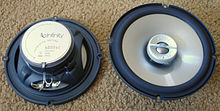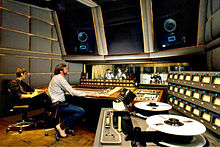- Coaxial loudspeaker
-
A coaxial loudspeaker is a loudspeaker system in which the individual driver units radiate sound from the same point or axis. Two general types exist: one is a compact design using two or three speaker drivers, usually in car audio, and the other is a two-way high-power design for professional audio, also known as single-source or dual-concentric loudspeakers.[1]
Car audio
 A car audio speaker with a coaxial tweeter in front of the woofer
A car audio speaker with a coaxial tweeter in front of the woofer
Coaxial speakers in automobiles are 2- or 3-way loudspeakers in which the tweeter, or the tweeter and a mid-range driver, are mounted in front of the woofer, partially obscuring it. The advantage of this design is the ability to use a smaller area, hence their popularity in car audio. The low frequency sound waves from the woofer are not reduced too much by the drivers in their path. Without time-alignment correction, the sound from the tweeter may arrive slightly before the sound from the woofer; this misalignment is not generally addressed in automobile sound systems.
This design was popularized in the 1970s with Electronic Industries, Inc. of South Holland, Illinois introducing the general concept in May 1973,[2] and Jensen Loudspeakers introducing a retail model the next month.[3] This was followed by designs from Sparkomatic, Clarion, Infinity and others.
Professional audio
 The studio monitors over the window are the URIE 813 model based on a 15-inch coaxial augmented with a plain 15-inch driver. The blue rectangles show where blue foam rubber has been applied to the edges of the high-frequency horns to attenuate undesired anomalies.
The studio monitors over the window are the URIE 813 model based on a 15-inch coaxial augmented with a plain 15-inch driver. The blue rectangles show where blue foam rubber has been applied to the edges of the high-frequency horns to attenuate undesired anomalies.
Coaxial loudspeakers in professional audio enable sound from two drivers to come from one source. This characteristic allows a wider field of listening to a synchronized summation of speaker drivers than loudspeaker enclosures containing physically separated drivers. As well, the pattern of response is symmetric around the axis of the loudspeaker.[4]
Since the 1943 introduction of the Altec Lansing 601 "Duplex" coaxial driver, recording studio monitors have often been coaxial loudspeaker designs. In 1945 the improved Altec 604[5] was introduced, and it soon became the recording industry standard studio monitor in the U.S.[6] First shown in 1947 in England, the Tannoy Dual Concentric design assumed the same role across Europe from the 1950s onward. The Altec 604 combined a 15-inch (380 mm) woofer with a compression driver attached to a horn to carry the high frequencies. The Tannoy also used a 15-inch woofer and a compression driver for high frequencies, but differed in that the woofer itself served as the final horn flare for the high frequency driver.[7] Thus, its output pattern was radially symmetric, not just mirror-image symmetric as in the Altec. Both designs placed the high frequency driver behind the low frequency driver, and both were not initially time aligned. The high frequencies arrived at the listener's ear slightly later than the low frequencies.
One drawback of the design is the production line difficulty in mating the two drivers, and in replacing or reconing the woofer. Another drawback is that the low frequencies tend to modulate the high frequencies, causing greater intermodulation distortion.[8] The Tannoy style of coaxial, with the woofer forming part of the high frequency horn, had greater intermodulation distortion. Designs similar to the Altec 604 have further problems with diffraction of the low frequencies around the central horn, and with rearward emanations from the horn body reflected forward by the woofer out of time with direct sound. All of the problems with sound waves tend to increase with sound pressure level, causing significant shifts in tone as the loudspeaker changes volume.[9]
In the late 1970s, Bill Putnam of Universal Audio worked with Ed Long and his patented Time Alignment crossover design to fix the long-standing problem of the two bandpasses not being aligned in time at their crossover point. The Altec 604 was given this elaborate new crossover feature and incorporated into the UREI 813 studio monitor, which also had a second woofer physically separate from the coaxial pair. This design dominated recording studios of the 1980s, and time alignment became a feature of competing manufacturers.[7] In the 2000s, digital signal processing (DSP) was used by Fulcrum Acoustics to reduce some of the coaxial drawbacks such the diffraction of the woofer's upper range around the central horn, by filling in this "shadow" with low frequency sound from the compression driver, and by countering the out-of-time reflections bouncing off of the woofer.[9]
Coaxial loudspeakers have been used in concerts for on-stage foldback duties, giving musicians a more even sound field because of the single-source characteristic. As well, the enclosure may be made more compact. McCune Sound in San Francisco used Altec 604s in a large proprietary stage wedge in the 1980s, and at the same time Professional Audio Systems (PAS), using Time Alignment technology from Ed Long, sold the popular SW series of compact stage wedges; offered with a 12- or 15-inch woofer, and having a projecting high-frequency horn as in the 604. Other stage monitors using coaxial designs are made by Clair Brothers, L-Acoustics, Radian Audio Engineering, RCF, Beyma, dB Technologies, Fulcrum Acoustics, and Rat Sound in partnership with Eastern Acoustic Works.[10]
References
- ^ Eiche, Jon F. (1990). Guide to Sound Systems for Worship. Recording and Audio Technology. Hal Leonard Corporation. p. 92. ISBN 079350029X. http://books.google.com/books?id=K1t0GxyvVbMC&pg=PA92.
- ^ "Car Speakers Hi-Fi Emphasis—Display Vital". Billboard (Nielsen Business Media) 85 (21): 37. May 26, 1973. ISSN 0006-2510. http://books.google.com/books?id=HgkEAAAAMBAJ&pg=PA37.
- ^ "Car Stereo". Billboard (Nielsen Business Media) 85 (25): 68. June 23, 1973. ISSN 0006-2510. http://books.google.com/books?id=GAkEAAAAMBAJ&pg=PA68.
- ^ Ballou, Glen (2005). Handbook for Sound Engineers. Focal Press, Gulf Professional Publishing. pp. 514–516. ISBN 0240807588. http://books.google.com/books?id=y0d9VA0lkogC&pg=PA516.
- ^ Audioheritage. Altec Duplex
- ^ McGowan, Chris (November 15, 1980). "Sound Pioneers". Billboard (Nielsen Business Media) 92 (46): 42. ISSN 0006-2510. http://books.google.com/books?id=SyQEAAAAMBAJ&pg=PT95.
- ^ a b Borwick, John (2001). Loudspeaker and headphone handbook (3 ed.). Focal Press. pp. 474–476. ISBN 0240515781. http://books.google.com/books?id=9DeZqnsjetgC&pg=PA474.
- ^ Dupont, Edward; Lipshitz, Stanley P. (September 2010). "Modeling the Intermodulation Distortion of a Coaxial Loudspeaker". Audio Engineering Society. http://www.aes.org/e-lib/browse.cfm?elib=15516. Retrieved May 1, 2011.
- ^ a b "Building a Better Coax". Fulcrum Acoustics. 2009. http://www.fulcrum-acoustic.com/technologies/buildingabettercoax. Retrieved May 1, 2011.
- ^ Frink, Mark (April 7, 2011). "Monitor Wedge Tips: Tools Of The Trade To Have A Successful Show". ProSoundWeb. http://www.prosoundweb.com/article/print/monitor_mixing_tips_tools_of_the_trade_to_have_a_successful_show. Retrieved May 1, 2011.
Categories:- Loudspeaker technology
Wikimedia Foundation. 2010.
